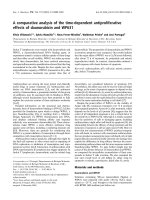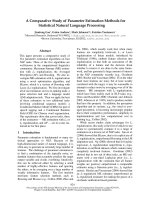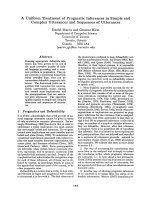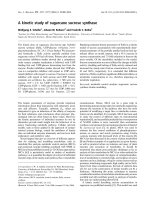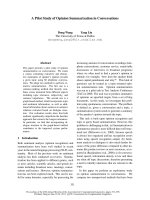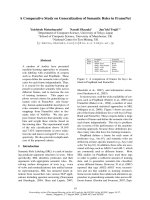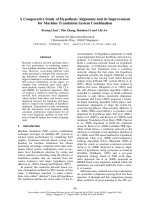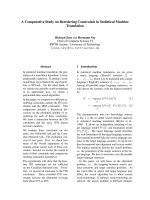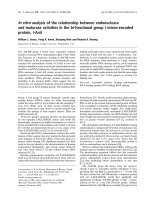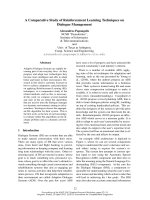Báo cáo khoa học: " A comparative study of gastrointestinal parasites between ranched and free ranging Burchell''''s zebra (Equus burchelli antiquorum) in Isiolo district, Kenya" ppsx
Bạn đang xem bản rút gọn của tài liệu. Xem và tải ngay bản đầy đủ của tài liệu tại đây (55.8 KB, 6 trang )
-2851$/ 2)
9H W H U L Q D U \
6FLHQFH
J. Vet. Sci.
(2004),
/
5
(3), 215–220
A comparative study of gastrointestinal parasites between ranched and free
ranging Burchell’s zebra (
Equus burchelli antiquorum
) in Isiolo district,
Kenya
Elizabeth N. Wambwa
1,
*, W.O. Ogara
2
, Dennis Mudakha
1
1
Kenya Wildlife Service, Veterinary Unit, P. O. Box 42076, Nairobi, Kenya
2
University of Nairobi Department of Public Health, Pharmacology and Toxicology, P. O. Box 29053, Nairobi, Kenya
Parasites were collected from 20 Burchell’s zebra,
Equus
burchelli antiquorum,
from Isiolo district, Kenya. 10 were
ranched animals from the Lewa Downs Ranch and 10 free
ranging from the areas adjacent to the ranch to the north.
The animals were culled from 4th to 18th June 1995. The
gastrointestinal tract was removed from the carcass and
separated as stomach, small and large intestines and
searched for parasites. The abdominal cavity was scrutinized
for
Setaria
species. The parasites were identified to genus and
in some cases species level. All animals were infected with at
least three genera of parasites of which at least one genus was
a nematode. A total of 10 genera representing eight families
were recovered from the two groups. These included six
nematode families
, Strongylidae
,
Atractidae, Oxyuridae,
Spiruridae, Setariidae,
and
Ascaridae,
one cestode family
,
Anoplocephalidae
and one family of the larvae of
Gasterophilus bot flies,
Gasterophilidae.
The most prevalent
families were
Atractidae
(100%) and
Gasterophilidae
(100%).
The principle nematode genera was
Crossocephalus
whose
total burden, plus or minus the standard deviation, was
3,471,129
±
1,352,922.
Setaria
species were recovered from
the abdominal cavity of 45% of all the animals examined.
The overall total worm burden was higher in the free
ranging zebra 2,743,410
±
849,604 than the ranched zebra,
787,669
±
246,006. The range of individual genera varied
from 0 to 269,225 in the free ranging group, which was
higher than 0 to 77,890 in the ranched animals. From
statistical analysis, no significant difference could be found
between males and females. However, the burdens of genera
Strongylus, Triodontophorus, Crossocephalus
and
Parascaris
were significantly higher in free ranging animals.
Key words:
Gastrointestinal, parasites, zebra, lewa downs
ranch
Introduction
Some of the earlier documented parasitological work in
zebra [1,18,21] led to the compilation of a checklist. This
checklist was considered incomplete because many reports
were incidental findings from sampling done at necropsy.
Secondly, in earlier records, the host was not defined to
species level [4], although these records were of substantial
value as true observations. It was difficult to arrive at any
assessment of the pathogenicity of many of these parasites.
More work has since been carried out in Burchell's zebra
giving attention to the total worm burdens, seasonal
prevalence and life cycles [4,14,15]. Parasitological
investigations such as these have been of value not only for
their contribution to the baseline information in domestic
equine helminthology [2], also suggests, a means of
providing a system either for monitoring overpopulation, or
disease in a population. However, for this you need a better
understanding of the population dynamics of both the host
and its nematode parasite.
The study area was selected following a study done by the
Kenya Wildlife Service (KWS), Veterinary Units field
veterinary staff [3], who between August and December
1991 reported morbidity and mortality among Burchel1’s
(Equus burche1li antiquorum)
and Grevyi zebra
(Equus
Grevyi)
. They found equine strongyloidosis to be a
predisposing factor for nutritional stress and mortality on
Lewa Downs Ranch in Isiolo District, Kenya. Mortality was
first reported in 1989 and said to be occurring annually
between August and December with the peak in September.
The mortalities were associated with an overal1 increase of
animals on the ranch, low precipitation and availability of
only coarse lignified pasture low in nutrients. This raised
particular concern about the long-term survival of the grevyi
zebra, which are listed as endangered by the International
Union for the Conservation of Nature. The initial study did
not quantify the gastrointestinal parasite burden, only
constituted a case response report. This study sought to
extend the work already done. Burchell's zebra were used in
*Corresponding author
Phone: +254-20-601806; Fax: +254-20-342857
E-mail:
216 Elizabeth N. Wambwa
et al.
this study since they are not endangered and were being
cropped regularly on the ranch. The study area also
presented an opportunity to make comparisons with free
ranging Burchells zebra in areas adjacent to the ranch.
The objectives of the study were to determine, (a) The
gastrointestinal parasite genera or species present in free
ranging and ranched Burchell's zebra in Isiolo District of
Kenya. (b) The total worm burden and the prevalence of the
parasites present. (c) If 1 and 2 are affected by the system of
husbandry. (d) The fecal egg count and how it correlated to
the size of worm burden.
Materials and Methods
Study area
During this study, 20 Burchell’s zebra were culled. Ten
were free ranging zebra from Isiolo district of Kenya. The
district is in the eastern province and located on longitudes
36
o
50' and 39
o
50'E and latitudes 0
o
05' and 2
o
N. The district
covers 25,605 square kilometer’s. Ten were ranched zebras
from Lewa Downs Game Ranch, which borders the semi-
arid Isiolo district to the south. It lies between longitudes
32
o
E and 37
o
E and latitudes 0
o
10' and 0
o
17'N.
The area is dry and hot for most of the year. Rainfal1 is
unreliable and scarce; however the two main rainfal1
seasons are the long rains between March and May and the
short rains between November and December. The area
receives an average rainfal1 of about 475 mm per annum
with a range from 237 mm in some area to 698 mm per
annum.
Animals
The 20 zebra were cul1ed between the dates 4/7/95 and
18/7/95. Animals selected for shooting were judged to be of
adult size and no discrimination by sex was made. The zebra
were shot in the neck with a .308 calibre rifle. This resulted
in instantaneous death in most cases. Upon examination, one
free-ranging and three ranched zebra were found pregnant.
Helminth Recovery
The zebras were then skinned and eviscerated fol1owing
techniques used in equids described [9,10]. Double ligatures
were placed at the esophageal entrance to the stomach, the
pylorus, and near the ileocecal junction. Cuts were made
between the ligatures to divide the gastrointestinal tract into
stomach, small intestines and large intestines. In this case
the stomach and smal1 intestines were placed into separate
buckets that were graduated up to 10 liters. The combined
large intestines were put into a large plastic tray measuring
170
×
135
×
33 centimeters. A small amount of feces were
collected from the rectum into plastic fecal pots for fecal
worm egg count. These were placed into a cool box and
transported back to the field laboratory. They were placed in
a fridge and examined within 2 days. Fecal egg counts were
carried out using MacMaster’s Technique [20].
The abdominal cavity was scrutinized for
Setaria
species.
Each organ was cut open and its ingesta emptied into the
respective containers. The gastrointestinal walls were
examined for worms adhering to the mucosa. The stomach
and small intestines contents were diluted to 10 liters with
water and the large intestines to 40 liters. Each container was
thoroughly mixed and random samples were taken to form
aliquots of 5% for stomach and small intestinal samples and
10% from the combined large intestines. Each aliquot was
put into a sieve of 150
µ
m
aperture and washed
continuously until all fecal matter was washed off and the
water was clear.
The gut washings were placed into polyurethane bags and
marked with a felt pen then placed in a cool box and
transported back to the laboratory. A few drops of 45%
iodine were added to the washings before examination to
kill and stain the helminths. The aliquots were examined in
small portions at a time with the aid of a 30X magnification
dissecting microscope. Each worm was picked out
individually and placed into 10% buffered formalin. Most of
the parasites could be seen macroscopically but
Crossocephalus
species required the use of microscopic
examination. The total worm burdens were based on the
aliquots taken of the complete specimen.
Helminth identification
Identification of large parasites was done under a
dissecting microscope (30X) and smaller parasites under a
compound microscope. Descriptions [7] were used for the
identification of the genera
Strongylus, Triodontophorus,
Cyathostomum, 0xyuris, Habronema, Seteria
and
Anoplocephala
[6] for
Crossocephalus
, and Gasterophilus
larvae [22]. The helminths were examined to genus or
species level and recorded separately.
The term prevalence, which is expressed as a percentage,
is defined as the number of individuals of the host species
infected with a particular parasite species divided by the
number of hosts examined [11].
In the statistical analysis, ranked parasite burdens of each
genera was compared using the Wilcoxon Rank Sum
(Mann-Whitney) Test, to statistically determine if there was
a significant difference between parasite burdens in males
versus females. In addition, to see if being ranched or free
ranging made any difference. This non-parametric test was
used due to the small sample size and unevenly distributed
data. Additionally, in order to discern the importance or
contribution to the total variation of the number of parasites
by the factors of sex or free ranging versus ranching,
multiple regression was done. A computer statistical
software application was used for the statistical analysis.
Gastrointestinal parasites in Burchell’s zebra 217
Results
Parasites recovered
Ten genera of gastrointestinal parasites were recovered
and identified to the genera level and in some cases to the
species level using various descriptions. The total and mean
parasite burdens and their prevalence are presented in
tabular form for the ranched zebra, and for the free ranging
zebra. The 10 genera recovered were from eight families.
Six nematode families found were
Strongylidae, Atractidae,
Oxyuridae, Spiruridae, Setariidae,
and
Ascaridae.
One
cestode family was recovered,
Anoplocephalidae,
and larvae
of the fly
Gasterophilus
from the family
Gasterophilidae
.
The genera
Habronema
and
Gasterophilus
were recovered
from the stomach
. Parascaris, Crossocephalus, Anoplocephala
and
Gasterophilus
recovered from the small intestines.
Strongylus, Triodontophorus, Cyathostomum, Crossocephalus,
Oxyuris
and
Anoplocephala
were recovered from the large
intestines.
On the whole, the most prevalent families were the
Atractidae
(100%) and the
Gasterophilidae
(100%). The
ranges of individual genera varied from an average of 0 to
77,890 from Lewa Downs Ranch zebra and 0 to 269,225 in
the free ranging zebra. When comparing the two groups, the
overall total parasite burden for all animals in the free
ranging group of zebras was higher at 2,743,410 ± 849,604
SD with a range of 0 to 2,692,255. The ranched animals had
a total worm burden of 787,669 ± 246,006 SD with a range
of 0 to 778,904.
Strongylidae
Strongylinae
An overall 90% prevalence of strongylids was found from
all the animals examined. Two species were recovered and
identified to genus level. The species
Strongylus
was the
second most abundant nematode and ranged from 280 to
4,740 for the free ranging zebra with 100% prevalence and 0
to 1,730 in the ranched zebra with 80% prevalence.
Triodontophorus
was recovered from only one animal on
the ranch, which had a total worm burden of 710. In the free
ranging group, there was a prevalence of 70% and burdens
recovered ranged from 421 to 32,088.
Cyathostominae
Nematodes of the genus
Cyathostomum
were recovered
from the large intestines of only one zebra from the ranched
group which had a total worm burden of 1250. Filamentous
prokaryotic organisms were noted attached to the anterior
and posterior extremities of the nematodes of this family.
This has been reported in her study on Burchel1s zebra
[4,5].
Atractidae
Only the genus
Crossocephalus
was consistently recovered
from the large intestines of all the animals from both groups.
It was the most prevalent (100%), and abundant nematode
recovered. The ranched animals had burdens ranging from
2506 to 170,872 and the free ranging zebra, 40,652 to
453,750.
Oxyuridae
Forty percent of all animals examined had
Oxyuris
nematodes. Two of the ranched animals were positive and
had total worm burdens of 94 and 103. In the free ranging
group, 6 animals were positive with burdens ranging from
520 to 2352.
Spiruridae
An overall of 30% of all animals were infected. Only
members of the genus
Habronema
were recovered from the
stomach. One zebra from the ranch was positive with a total
count of 32 while 50% of the free ranging zebra were
affected and had burdens ranging from 54 to 652. Some of
these parasites were pulled out of nodules in the mucosa of
the stomach.
Setariidae
There was a 45% overall infection rate. Two of the
ranched animals had the nematode,
Setaria equina
. Each
had 3 parasites. 70% of the free ranging zebra were infected
with the same nematode and numbers ranged from 1 to 4.
Ascaridae
Parascaris equorum
was recovered from 30% of all the
animals. None of the ranched animals were positive for this
nematode. The free ranging zebra had a range of 1 to 2.
AnoplocephaIidae
Eighty percent of animals examined both ranched and free
ranging were infected. Worms collected mainly from the
caecum and colon. The only cestode recovered in the study
was from the species
Anoplocephala Perfoliata
. In the
ranched animals, they ranged from 12 to 71 and were found
in al1 the animals. The free ranging group had burdens
between 11 to 98 and 6 animals were affected. They left
ulcerated and inflamed areas when detached from the
mucosa.
Gasterophilus larvae (Bots)
These were consistently present and attached to the
glandular stomach of al1 zebra. They were sampled in fairly
high numbers with ranges of 152 to 451 and 180 to 613 in
the ranched and free ranging groups respectively.
The non-parametric Wilcoxon Rank Sum Test was
applied at a 5% confidence level. When tested for sex, no
significance could be demonstrated in the parasite burdens if
the zebra was female or male. When tested for free ranging
versus ranched animals, significance was shown for the
218 Elizabeth N. Wambwa
et al.
genera
Strongylus, Triodontophorus, Crossocephalus
and
Parascaris.
These were significantly higher in free-range
zebra. There was not enough evidence to statistically
demonstrate a difference in the total burdens of the genera
Cyathostomum, Oxyuris, Habronema, Setaria, Anoplocephala
and
Gasterophilus.
Results from multiple regression show
that as far as free ranging versus ranching was concerned,
significant difference was found for 3 genera of parasites
.
Strongylus, Crossocephalus
and
Parascaris
were present in
statistically significant higher burdens in the free ranging
zebra. For
Triodontophorus, Oxyuris, Habronema,
and
Gasterophilus,
the p-values were close but not within the
level of significance. If any difference existed between the
two groups, there is too little data available to discern it. The
test also showed that the burdens of genera
Setaria
and
Anoplocephala
were not significantly different whether the
animal was ranched or free ranging.
Fecal egg counts
The fecal egg count in the ranched animals ranged from
650 to 1,800 with a mean egg count of 1,225 ± 104.2. The
free-range animals had counts of 1,050 to 2,150 and a mean
of 1,620 ± 204 using the wilcoxon rank sum test. There was
no significant difference in the total eggs per gram between
the two groups. In comparing the mean total worm burdens
to the total egg counts, there were general1y higher egg
counts in animals with higher worm burdens, however, no
statistical difference could be found between the ranched
and free ranging animals.
Discussion
Most genera of parasites were recovered from the large
intestines including those that are of most parasitic importance
such as the large strongyles. The large intestines therefore
appear to be an important portion of the gastrointestinal tract as
far as parasitism in zebras is concerned.
All zebra examined were infected with at least 3 genera of
parasites of which at least one was a nematode. The genera
of nematodes recovered were similar to those reported in
other studies done on Burchells zebra [4,5,14,15,16], but
less diversity was recorded.
This may have been due to the fact that the study was
conducted over a short period and therefore was not as
intensive as other studies that have been done. In addition,
having been carried out within one season only, it cannot
present a complete picture of the nematodes that could be
present in that group of zebras in Isiolo District as seasonal
study would.
Of the large strongyles,
Craterostomum and Oesophagodontus
were not found in this group of zebra. In the sub-family
Cyathostominae,
only the genus
Cyathostomum
was
recovered from one ranched animal. A previous study done
at Lewa Downs on zebra [3] recovered other species of
Cyathostomes, namely
Cylindropharynx
and
Cylicocyclus
species which were not found in this study together with
approximately 50 other species recorded in equine.
Cyathostomes nearly always exist in equids however in this
case, they must have gone undetected. For practical reasons,
only small aliquots of the combined large intestinal contents
could be examined making it possible to miss them. The
burdens may also have been low due to other factors that
affect strongylid numbers such as climatic and
environmental factors. For instance, the arid climate may not
support a great abundance of strongylids. Other host factors
may have included age resistance.
Similar to the other studies done in Burchel1's zebra that
are mentioned in this paper, the family
Atractidae
was the
most abundant recovered in this study. Only the species
Crossocephalus
was found. The species
Probstmayria
that
has been recovered in other similar studies was not found.
The high numbers of this species are attributable to its
viviparous life cycle, which it completes entirely in one host.
In addition, Scialdo-Krecek found that Atractids were more
successful in an arid climate [15,16]. The numbers
recovered could probably have been higher had a mucosal
digestion been done.
The
Parascaris
species were found in low numbers. The
Setariids were found in 45% of the animals examined. The
prevalence of this parasite may have been higher however
the parasite is difficult to locate within the abdominal cavity.
The three acknowledged species within the
Habronema/
Draschia
complex are ubiquitous presumably due to the
universal distribution of their major intermediate hosts
Muscae domestica
and
Stomoxys ca1citrans
[17].
Drachia
species were not found in this study although it has been
reported in high prevalence in equids in tropical Africa. The
intensities reported are related to the abundance of their
vectors, highest numbers occurring in the summer months
[14,15,16]. Thirty percent of the animals were infected with
Habronema species. The limited numbers of
Habronema
found in this study may have been because the weather may
not have favored their vectors. Also since few
Habronema
species are found free in the stomach after death [8]. Most
are still associated with the mucosa and during this study; a
mucosal digestion was not done.
The oxyurids were not found in very high numbers and
this was to be expected, as large numbers are usual1y found
in foals.
Other work on Burchell’s zebra [14] also recovered
cestodes of the genus
Anoplocephala
. These were found
consistently in this study in numbers ranging from 11 to 98.
The clinical significance of cestode infections is usually
difficult to ascertain. Most pathology attributed to these
parasites is from natural infections and other contributing
factors cannot be ruled out [8].
The statistical results seem to suggest that there is no
difference in the parasite burdens if the animal is a male or
Gastrointestinal parasites in Burchell’s zebra 219
female. Also that there are higher burdens of particular
genera of parasites
(Strongylus, Triodontophoms, Crossocephalus
and
Parascaris)
in the free-range zebra compared to the
ranched. However, it is difficult to draw any conclusions
from this analysis due to the fact that our sample size was
too small to demonstrate conclusively a clear difference in
our comparisons. Additionally, there was an unequal
number between the females and males. A larger sample
size would have to be used to obtain results that one can
make inferences from.
Some genera recorded in other studies were not recovered
in this study.
Strongyloides westeri
in the family
Strongyloididae
has been reported in Burchell's zebra [4],
[5] recovered from small intestines. It is a nematode
common in young foals although occasionally reported in
adults [7].
No helminths from the family
Trichostrongylidae
were
recovered.
Trichostrongylus axei
Cobbold, 1879 is a
widespread parasite of equids occurring in most parts of the
world [7]. It has been reported in Burchell’s zebra however
the location of its host is not given [13]. Although
widespread, few reports of its occurrence in equids are
available. One of the reasons for its reported low prevalence
or absence in some studies may be due to its relatively small
size compared to other nematodes of equids, making it
easily overlooked [12].
Trichostrongylus thomasi,
Monnig
1932 has also been reported in Burchell's zebra in Kruger
National Park, South Africa [4,5].
The trematodes of
Gastrodiscus
species, which have been
reported in the small intestines of equine, were not
recovered in this study. It has been reported recovered from
a Grevyi zebra [19]. This parasite normally occurs in Africa
and requires an intermediary host, a fresh water mollusc.
The most likely reason for its absence was the lack of its
intermediate host in an arid area such as Isiolo District.
Free ranging wild animals have evolved over millions of
years and under normal conditions live in a state of
equilibrium with their parasites. Although young and
stressed animals with large burdens may suffer from ill
health, this resistance to helminth infestations in adult
wildlife species probably results from immunity stimulated
by the continuous challenge in the first year of life. In this
study, all the animals examined were apparently healthy. It
was expected that the study would find a higher
gastrointestinal burden in ranched animals due to the stress
they undergo of confinement with poor grazing and high
populations.
However, it was found that the free ranging animals had
higher parasite burdens. This difference was partly attributed
to the change in the management practice on the ranch since
1989 when equine strongyloidosis was diagnosed on the
ranch. The predominant genera of parasites identified at that
time were
Strongylus, Trichostrongylus, Cylindropharynx
and
Cylicocyclus
. Management practices that were advised
and adopted on the ranch at that time included reducing
herbivore density by continual removal of Burchell's zebra
through a cropping program. In addition, pasture
management by encouraging rotational grazing through
controlled burning. This helped to reduce the number of
infective larvae on the ground possibly leading to a
reduction of parasites that have free living stages such as the
strongylids and oxyurids. Since the pasture burning started
the zebra mortality has reduced with improved overall
quality of pasture and reduced the nutritional stress.
This study should serve as a preliminary study to other
epidemiological studies, which look into parasite burdens in
the zebra through the different seasons.
Acknowledgments
Kenya Wildlife Service (KWS) for providing the study
and field support, Lewa Downs Ranch for providing some
zebras and slaughter facilities. International Institute of
Parasitology, St. Albans, UK where the laboratory work was
done. University of Rome, Department of Parasitology La
Sapiensa for travel support to Lewa Downs for the second
author.
References
1. Boulenger CL. On some nematode parasites of the zebra.
Parasitology, 1920, 12, 98-107.
2. Horak IG. Helminths, arthropods and protozoan parasites of
mammals in African savannas. In: Bourliere F (ed.). Tropical
Savannas. pp. 730, Elsevier Scientific Publishers, Amsterdam,
1983.
3. Kenya Wildlife Service (KWS). Field Veterinary Report,
Clinicopathological investigation of zebra strongyloidosis. A
study of zebra seasonal mortalities on Lewa Downs Ranch,
Isiolo, Kenya, August, 1991.
4. Krecek RC, Reinecke RK, Malan FS. Studies on the
parasites of Zebras. V Nematodes of the Burchel1's and
Hartmann’s Mountain Zebras from the Etosha National Park,
South West Africa/Namibia. Onderstepoort J Vet Res 1987,
54, 71-78.
5. Krecek RC, Malan FS, Reinecke RK, De Vos V. Nematode
parasites from Burchell's Zebras in South Africa. J Wildlife
Dis 1987, 23, 404-411.
6. Le Van Hoa. Nematodes parasites de mammiferes, reptiles et
amphibiens du Congo. Phasmidiens. Parc National de
L’Upemba (Mission G. F. dc Witte), 1962, 65, 1-58.
7. Lichtenfels JR. Helminths of domestic equids. Illustrated
key to genera and species with emphasis of North America
forms. Proceedings of the Helminthological Society of
Washington, 42 Special Issue, pp. 192, 1975.
8. Lyons ET, Tolliver SC, Drudge JR, Swerczek TW, Crowe
MW. Parasites in Kentucky Thoroughbreds at necropsy:
Emphasis on stomach worms and tapeworms. Am J Vet Res
1983, 44, 839-844.
9. Malan FS, Reinecke RK, Scialdo Rosina C. Recovery of
220 Elizabeth N. Wambwa
et al.
helminths post mortem from equines. I. Parasites in arteries,
subperitoneum, liver, and lungs. Onderstepoort J Vet Res
1981,
48
, 141-143.
10.
Malan FS, Reinecke RK, Scialdo Rosina C.
Recovery of
helminths post mortem from equines. IT Helminths and
larvae of
Gasterophilus
in the gastrointestinal tract and
oestrids from the sinuses. Onderstepoort J Vet Res 1981,
48
,
141-143.
11.
Margolis L, Esch GW, Holmes JC, Kuris AM, Schad GA.
The use of ecological terms in parasitology (Report of an ad
hoc committee of the American Society of Parasitologists). J
Parasitol 1982,
68
, 131-133.
12.
Pandey VS, Ouhelli R, Verhulst A.
Epidemiological
observations on the stomach worm of donkeys in Morocco.
Vet Res Commun 1992,
16
, 273-279.
13.
Round MC.
Check list of the helminth parasites of African
mammals of the orders Carnivora, Tubulidentata,
Proboscidea, Hyracoidea, Artiodactyla and Perrissodactyla.
1968.
14.
Scialdo RC, Reinecke RK, De Vos V.
Seasonal Incidence of
Helminths in the Burchell's Zebra. Onderstepoort J Vet Res
1982,
49
, 127-130.
15.
Scialdo-Krecek RC.
Studies on the parasites of Zebras 1.
Nematodes of the Burchells Zebra in the Kruger National
Park. Onderstepoort J Vet Res 1983,
50
, 111-114.
16.
Scialdo-Krecek RC, Reinecke RK, Biggs HC.
Studies on
the parasites of zebras. III. Nematodes of the Mountain zebra
from the farm “Keplie” and the Namib-Naukluft Park, South
West Africa/Namibia Onderstepoort J Vet Res 1983,
50
, 283-
290.
17.
Soulsby EJL.
Helminths, Arthropods and Protozoa of
Domesticated Animals. Bailliére Tindall, London, 1982.
18.
Turner H.
On the nematode parasites of Chapman’s Zebra,
pp. 441-451. Proceedings of the Zoological Society of
London, 1920.
19.
Vevers GM.
Report on the Entozoa collected from animals,
which died in the Zoological Gardens-of London during 8
months of 1919-1920. pp. 405-410, Proceedings of the
Zoological Society of London, 1920.
20.
Witlock HV.
Some modifications of the Macmaster helminth
egg counting technique and apparatus. J Coun Sci Ind Res
Aus 1948,
21
, 177-180.
21.
Yorke W, Southwell T.
Crossocephalus zebrae n. sp. Ann
Trop Med Parasitol 1920,
14
, 127-135.
22.
Zumpt F.
Myiasis in Man and Animals in the Old World.
Buttersworth, London, 1965.
